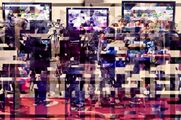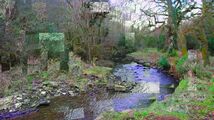Environmental cubism: Difference between revisions
>PJosepherum mNo edit summary |
>Oskykins No edit summary |
||
| Line 1: | Line 1: | ||
[[category:Visual distortions]] | [[category:Visual distortions]] | ||
'''Environmental cubism''' is a distortion characterized by a visual segmenting or partitioning of the external environment into squares and cubes of varying amounts and sizes. Once established, these partitions begin to slowly drift away from their original location and often change in size leading to gaps that are formed in between them. The space within these gaps is either completely dark or composed of tightly bound [[Visual effects: Geometry (dissociative)|visual geometry]]. This dark space can eventually grow, progressively decreasing the size of the cubes until the tripper finds themselves surrounded by the [[Disconnective effects: Disconnection from visual input#Holes, spaces and voids|dissociative hole]]. It is not uncommon to be able to innately feel and detect the details and layout of both the different sections of the distortion and the gaps between them. | '''Environmental cubism''' is a distortion characterized by a visual segmenting or partitioning of the external environment into squares and cubes of varying amounts and sizes. Once established, these partitions begin to slowly drift away from their original location and often change in size leading to gaps that are formed in between them. The space within these gaps is either completely dark or composed of tightly bound [[Visual effects: Geometry (dissociative)|visual geometry]]. This dark space can eventually grow, progressively decreasing the size of the cubes until the tripper finds themselves surrounded by the [[Disconnective effects: Disconnection from visual input#Holes, spaces and voids|dissociative hole]]. It is not uncommon to be able to innately feel and detect the details and layout of both the different sections of the distortion and the gaps between them. | ||
| Line 13: | Line 12: | ||
===See also=== | ===See also=== | ||
*[[Subjective effects index]] | |||
*[[Psychedelics#Subjective_effects|Psychedelics - Subjective effects]] | *[[Psychedelics#Subjective_effects|Psychedelics - Subjective effects]] | ||
*[[Dissociatives#Subjective_effects|Dissociatives - Subjective effects]] | *[[Dissociatives#Subjective_effects|Dissociatives - Subjective effects]] | ||
*[[Deliriants#Subjective_effects|Deliriants - Subjective effects]] | *[[Deliriants#Subjective_effects|Deliriants - Subjective effects]] | ||
Revision as of 14:55, 7 May 2014
Environmental cubism is a distortion characterized by a visual segmenting or partitioning of the external environment into squares and cubes of varying amounts and sizes. Once established, these partitions begin to slowly drift away from their original location and often change in size leading to gaps that are formed in between them. The space within these gaps is either completely dark or composed of tightly bound visual geometry. This dark space can eventually grow, progressively decreasing the size of the cubes until the tripper finds themselves surrounded by the dissociative hole. It is not uncommon to be able to innately feel and detect the details and layout of both the different sections of the distortion and the gaps between them.
This effect is remarkably similar in its appearance to cubist photography and artwork.
-
Photo montage by David Hockney
-
Chrono Cubist by Diego Kuffer
-
"Cubism woods" by Chelsea Morgan
Click here for full gallery.


